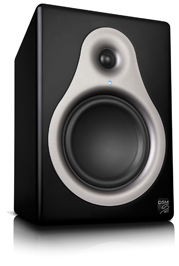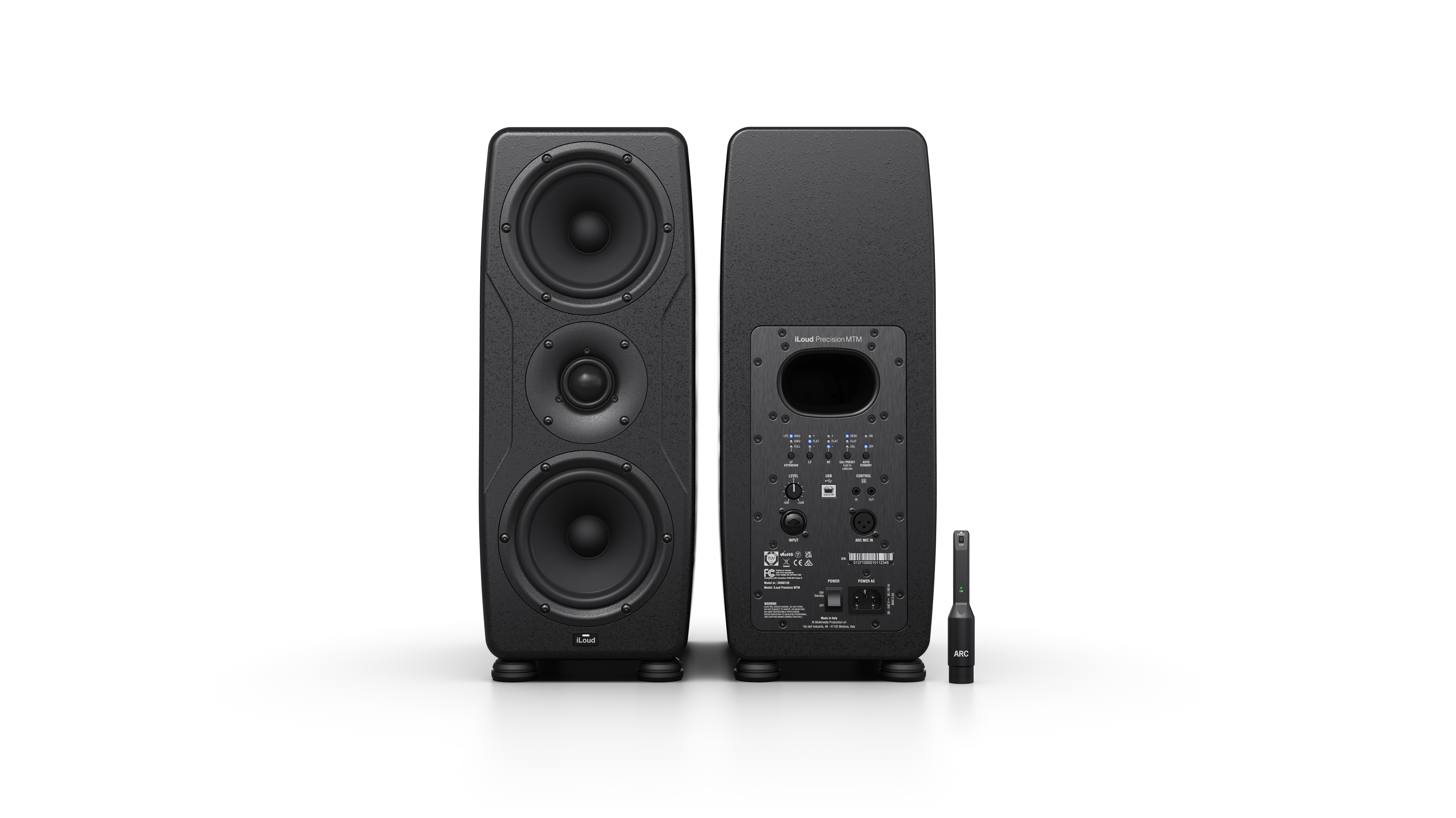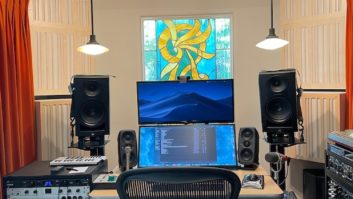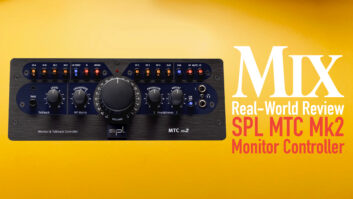
The DSM2 speakers were designed in tandem by M-Audio and Digidesign.
From its top-end EX66 ($699.95 each) midfields to the diminuitive Studiophile AV 20 desktops, M-Audio offers a wide range of studio monitors. Now, a design collaboration with sister company Digidesign results in two new near-field models: the Studiophile DSM2 (reviewed here) and the smaller Studiophile DSM1. This new effort has produced a monitor rivaling the reproduction characteristics of more costly units.
The larger of the two new monitors, the DSM2 ($749 each) has an 8-inch LF driver with steel-frame construction and an anodized-aluminum cone. The published frequency response is 42 to 27k Hz, ±3 dB, and I can attest that the 1-inch, soft-dome, Ferrofluid-cooled tweeter is smooth and open in the “air” frequencies above 16 kHz. The 2.7kHz digital crossover uses 24dB/octave Linkwitz-Riley filters. All crossover, EQ and channel-assignment functions are performed via 36-bit DSP. Incoming analog signals are converted to 24-bit/96kHz for processing before the signal hits the amplification stage. This could be an issue for some engineers hoping to avoid another conversion after their final D/A output. But to ensure the necessary levels of precision in the processing stage, the tasks are performed in the digital domain.
The onboard bi-amplification uses separate Class-D power amplifiers — LF, 100 watts; HF, 80W — plenty for lengthy listening sessions at non-ear-fatiguing volumes. Dual anti-clipping limiters are standard, with the HF limiter kicking in when it detects 0.5-percent THD — or 5 percent in the case of the woofer. The limits can readily be found when you push the speakers hard in a large control room.
The back panel has analog XLR and TRS input jacks, and a single, global -10dBV/+4dBu input sensitivity switch. M-Audio says these dual analog inputs are “summed” so that both connectors can be used simultaneously. Digital inputs are XLR AES/EBU or coaxial S/PDIF, with an input source switch for analog, digital or digital standby. A loop thru for S/PDIF can send a digital signal to your other speaker, and a Channel Assign switch designates which channel routes to each speaker. A built-in PLL circuit re-clocks the incoming digital signal, with published jitter less than 250 picoseconds. No external word clock inputs are provided. Incoming signals are automatically detected, with the DSM2 accepting standard frequencies between 44.1 and 192 kHz — ±10 percent at 16- or 24-bit resolution. Also on the rear panel, a Volume Trim control operates in the digital domain, providing continuous input sensitivity adjustable from -22 to +10 dB.
But Wait, There’s More
To address particular acoustical challenges, 12 back panel DIP switches provide access to the DSM2’s onboard digital EQ; high shelf, low shelf, mid-EQ, highpass and cuts (220/200/175 Hz) are all switch-selectable. There are no specifications for the shelves or the midrange bump on the speaker itself, but included charts show the exact characteristics of each filter. Intended for use with an optional subwoofer, the highpass has a selectable 40/60/80/100Hz roll-off point. The HF and LF shelves, and the midrange EQ bump provide +1.5dB to -3dB variance in 1.5dB increments. Both the low and high shelves start their processing at 1 kHz, whereas the midrange center frequency is just a few cycles shy of 800 Hz. The 220/200/175Hz adjustments are called Desktop Filters and are useful when you are placing speakers on a meter bridge or a desk.
Knowing that the room in which I was testing had a resonant build-up around 160 Hz, I used the 175Hz filter to cut 3 dB out of the low midrange, making the DSMs sound much more like the JBL LSR 6328Ps I am accustomed to. These are very usable filters, providing an easy fix for the majority of positioning issues. The DSM2s offer no “auto-calibration,” test tones/noise generation, test mics or actual audio guides for calibration. Situational examples — such as corner or meter bridge placement — are provided in the manual, but you must still perform the necessary testing to ascertain proper filter settings.
How Do They Sound?
On first listen, I simply played what I had with me as I was not working in my studio. Steely Dan’s Two Against Nature CD was first up. All the nuance of the opening snare and hi-hat work of “Gaslighting Abbie” was reproduced with the detail I’ve come to know on higher-end speaker systems. The vocals sat perfectly in the mix. I was immediately impressed. Prince’s “3121” had the punch in the low end, and clarity and presence in the midrange, reproducing the wonderfully wacky sounds of that record with no unusual resonance or coloration.
Once in my studio, I balanced the DMS2s’ volume against my JBLs to provide a familiar reference. Remarkably, they were similar in sound quality. Vocal placement and imaging were virtually identical, especially after inserting the 175Hz Desktop Filter. The very upper end of the HF range was also similar, with harmonics reproduced accurately from both 24/96 and 16/44.1 Pro Tools files. Naturally, when reproducing things like strings, there were differences between the two systems. Some bowing was noted to recede on the DMSs, by comparison. This would sometimes translate to a difference in the sound of the snare drums. However, keep in mind that these are minute differences between two systems in completely different price ranges.
To test the digital inputs, I used a digital send from a Lynx Aurora 8 AD/DA converter. The DSM2’s digital inputs (and subsequent conversion to analog) held up quite nicely next to the more expensive Aurora system. The imaging was spot-on with vocal tracks, guitars and drums. I did notice some differences in timbre on a bright side-stick and sibilance on the vocals, the DSMs’ reproduction being somewhat brighter in the 6 to 8kHz range. This translated to the fifth vocal part above the root coming forward slightly by comparison. All in all, these slight nuances are going to be evident in any system comparison. One drawback to the digital inputs is the necessity for some form of volume control. In a networked speaker system, volume can be addressed in the analog domain after the D/A conversion. I would love to see a future DSM2 version with this capability.
Accuracy, Accuracy, Accuracy
These speakers stand up to the rigors of current, competitive design criteria, meaning that they sound really good next to similar speakers in their class, and above. They’re punchy in the extended low end without being tubby and accurate on the top. Imaging is solid. The DSM2s would be a welcome addition to any production environment. At this price point, this level of accuracy is a bargain.
Bobby Frasier is an engineer, consultant and guitar player for Beatle cover band Marmalade Skies.








